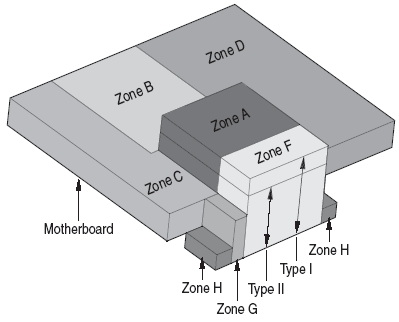Sneak Preview: Intel Alderwood/Grantsdale Chipsets
Volumetric Zones
Physical conflicts occur time and time again between the various components, which, for many users, put a damper on installing top-of-the-line hardware. For instance, large CPU coolers frequently cannot be installed because the capacitors around the processor socket get in the way. To name another example, in order to expand the system memory, you are often forced to take apart half of the computer because cables are blocking the way. Factors such as electromagnetic interference or the best possible motherboard routing have led to the development of BTX (formerly known as "Big Water").
BTX deals with these problems by dividing the system into Volumetric Zones, which are based on the components they contain. There are zones for motherboard components, case parts, components that are difficult to categorize (e.g. extension cards, cables, airflow routes) and others (e.g. drives, front panel extensions). Accordingly, only components that conform to BTX (i.e., components that remain within their respective zones) will be allowed in the future.
Get Tom's Hardware's best news and in-depth reviews, straight to your inbox.
Current page: Volumetric Zones
Prev Page BTX Form Factor: More Efficient Layout For Components Next Page BTX, MicroBTX, PicoBTX
Patrick Schmid was the editor-in-chief for Tom's Hardware from 2005 to 2006. He wrote numerous articles on a wide range of hardware topics, including storage, CPUs, and system builds.
